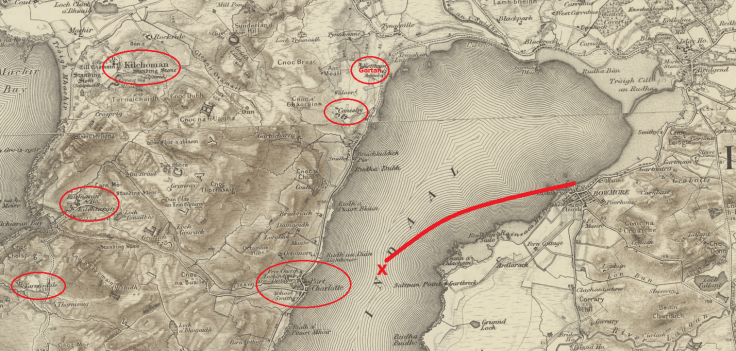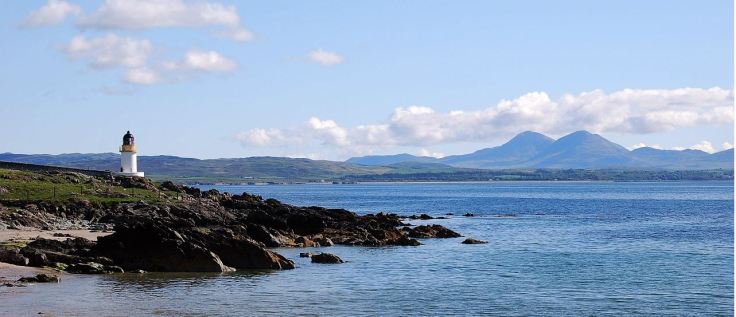Over the centuries nearly every coastal town and island community in Scotland has experienced a loss of life as a result of a maritime tragedy. We can read about Scottish history from the ancient times right up until the present day and find stories of shipwrecks, drownings and of lucky survivors.
Some of these events are well remembered and commemorated, while others have fallen out of memory. Sadly, some of the great maritime disasters of our past only live on in the research of family historians who chance upon a discovery and give fresh recognition to the tragedies of the past.
I recently stumbled across one such maritime accident that claimed the lives of thirteen people, including two from my own family.
On the 14th of November, 1879 people from all over the island of Islay were in Bowmore to attend a seasonal feeing market. It was an opportunity for farm servants to catch the attention of farmers and to secure employment for the coming season.
As the day came to a close, a group of people from the Parish of Kilchoman boarded a small boat to make the three mile journey across Loch Indaal, from Bowmore to Port Charlotte.
Thirteen people, including the owner Archibald Turner, piled into the 13.5 foot long boat. One of the party, Archibald McLellan, warned his companions that the boat was overloaded and unsafe. He took a fateful decision and refused to get on board, instead choosing to walk the long road around the loch to his home at Kilchiaran. His brother and two sisters chose to stay on the boat.
Unconvinced by McLellan’s warnings the party set sail from Bowmore as the wind blew from the south. The sailing initially went well but about half way between Gartbreck and Port Charlotte the boat entered the more exposed waters that are unprotected by Laggan Point.
As they reached the rougher conditions at the centre of the loch, the boat began to dip and sway. Water inundated the vessel and it capsized, throwing the passengers into Loch Indaal. All thirteen of those on board subsequently drowned.

The names of those that perished
John McLellan, 21 years old, Kilchiaran.
Janet McLellan, 17 years old, Kilchiaran.
Margaret McLellan, 26 years old, Kilchiaran.
Duncan McLean, 26 years old, Port Charlotte.
Robert MacKenzie, 48 years old, Port Charlotte.
John Torrie, 28 years old, Port Charlotte.
Margaret Johnstone, 17 years old, Conispie.
Catherine Ferguson, 25 years old, Portnahaven.
Ann MacLachlan, 18 years old, Kilchoman.
Archibald Turner, 32 years old, Gortan.
Duncan Sinclair, 27 years old, Tormisdale.
Archibald Anderson, 18 years old, Tormisdale.
Catherine Anderson, 23 years old, Tormisdale.
My ancestor, Mary Anderson of Tormisdale was the Aunt of the Archie and Catherine Anderson who were killed at Loch Indaal. Mary had moved away from Islay in the 1840s, appearing on the 1851 census in Renfrewshire and working as a servant alongside an Irishman Thomas Hardie, who she married just a few months later. At the time of the Loch Indaal tragedy they lived at Hill Street in Greenock.
The body of her niece Catherine took three months to find, eventually being recovered on the shore about half a mile west of Bowmore on the 13th of Feburary, 1880. Archibald Anderson’s body was also recovered and the siblings were buried together at Kilchoman Churchyard.

The remains of at least twelve of the thirteen victims were eventually found. Catherine Ferguson’s body washed ashore on the western side of the loch, near Coultorsay Farm, while John McLellan was found about a mile from Port Charlotte. A search party that was sent to find survivors also discovered the remains of the boat smashed into pieces against the rocks.
The tragedy was a devastating blow to the island and made news all over the world. Newspapers in Glasgow, London and Australia all included stories about the victims. In 1879 the population of Islay had been steadily declining with many families emigrating to the colonies. It’s unsurprising that this story had international interest given the network of Islay émigrés across the world.
On the 3rd of May, 1880, Archie Gillespie of Leckgruinart wrote a letter to his brother John in Canada,
I would write sooner than this if it had not been for that boat accident in Loch Indall for I don’t like to write to your family till you would get it from some of his own friends. But we are missing Robert writing for he always stop with us every time he would be in this district and he slept with myself the week before he was lost. I was in Port Charlotte at Parochial Board meeting next week after the accident and there were three of them found that day and I saw them. Dougall McLelland and two (indecipherable) and Duncan Sinclair, Tormisdale. But Archie Turner the owner of the boat and granddaughter of Don MacLachlan, Balinaby, is not found yet. The rest is all found.
Archibald McLellan, who chose to walk home instead of boarding the unsafe boat, lived on Islay for the rest of his life. He got married, worked as a Road Surfaceman and continued to have children right up until his death in 1923, at the age of 66.
In a sense the Loch Indaal tragedy is unremarkable in that it was one of dozens of such accidents around the shores of Islay. Yet it was still an event that had profound significance for the families of the victims and for their community as a whole. It is a sad irony of history that important events can, with the passage of time, become nothing more than a small footnote in history.


Always good to read your stories, including these sad ones. I was in Barra in 2011 and drove over to Vatersay where I saw the cairn about this:
One of the saddest events to befall the island happened when the Annie Jane, a three-masted immigrant ship out of Liverpool bound for Montreal, Canada, struck rocks off West Beach during a storm in September 1853. Within ten minutes the ship began to founder and break up casting 450 people into the raging sea. In spite of the conditions, islanders tried to rescue the passengers and crew.[11]
Reblogged this on firefly465.
What a dreadful story – I had never heard of this. So many young people. It would have struck right at the heart of Islay. And the man who made the decision to walk must have been haunted too, all his life. Thank you for sharing their stories.
Hello Colin
I am also a descendent of Mary Anderson .
I am on Islay at the moment .
Do you have any information about an address where Mary Anderson may have lived .
I have previously visited the grave yard in Kilchoman .
I would be very grateful for any information you can give me .
Are there any of the Anderson line still living on Islay ?
Hi Helen, thanks for getting in touch. Mary Anderson was born at Tormisdale on Islay in 1829. She was still living at Tormisdale by the time of the 1841 census alongside her parents and siblings. In March 1851 she was listed as being resident at High Lawfield Farm near Kilmacolm in Renfrewshire, working alongside Thomas Hardie, who she later married in November 1851.
I haven’t done much research on Mary’s siblings so unfortunately I’m not sure if there are any descendants still living on Islay. I know that her brother Colin was still living on the island in 1871 but as for the rest, I’m not sure.